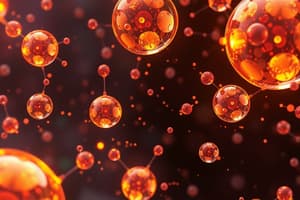Podcast
Questions and Answers
A catalyst accelerates a chemical reaction by which mechanism?
A catalyst accelerates a chemical reaction by which mechanism?
- Increasing the equilibrium constant of the reaction.
- Providing an alternative reaction pathway with a lower activation energy. (correct)
- Being consumed during the reaction.
- Increasing the overall Gibbs free energy change (ΔG) of the reaction.
Which statement accurately describes how a catalyst influences chemical equilibrium?
Which statement accurately describes how a catalyst influences chemical equilibrium?
- It increases the concentration of products at equilibrium.
- It accelerates the rate at which equilibrium is reached, without changing the equilibrium constant. (correct)
- It shifts the equilibrium position towards the reactants.
- It shifts the equilibrium position towards the products.
In homogeneous catalysis, what is the primary characteristic of the catalyst relative to the reactants?
In homogeneous catalysis, what is the primary characteristic of the catalyst relative to the reactants?
- It is always a solid, regardless of the reactants' phase.
- It exists in a different phase from the reactants.
- It exists in the same phase as the reactants. (correct)
- It does not interact directly with the reactants.
In heterogeneous catalysis, what is the first step that must occur for the reaction to proceed?
In heterogeneous catalysis, what is the first step that must occur for the reaction to proceed?
What is the meaning of 'catalyst selectivity'?
What is the meaning of 'catalyst selectivity'?
Why are zeolites used as catalysts in the petroleum refining and petrochemical industries?
Why are zeolites used as catalysts in the petroleum refining and petrochemical industries?
In the context of catalysis, what is 'poisoning'?
In the context of catalysis, what is 'poisoning'?
A chemical company is looking to optimize the production of a specific pharmaceutical compound. They notice that a byproduct is forming, reducing the yield of the desired product. How could a catalyst be used to address this problem?
A chemical company is looking to optimize the production of a specific pharmaceutical compound. They notice that a byproduct is forming, reducing the yield of the desired product. How could a catalyst be used to address this problem?
A catalytic converter in a car uses solid catalysts to reduce harmful emissions. Which of the following best describes the process?
A catalytic converter in a car uses solid catalysts to reduce harmful emissions. Which of the following best describes the process?
How does a catalyst affect the energy profile of a chemical reaction?
How does a catalyst affect the energy profile of a chemical reaction?
Flashcards
Catalysts
Catalysts
Substances that speed up chemical reactions without being consumed; they lower activation energy, accelerating reaction rates without altering thermodynamics.
Homogeneous Catalysis
Homogeneous Catalysis
A type of catalysis where the catalyst and reactants are in the same phase, typically in a solution.
Heterogeneous Catalysis
Heterogeneous Catalysis
A type of catalysis where the catalyst and reactants are in different phases, commonly with a solid catalyst and liquid or gas reactants.
Activation Energy
Activation Energy
Signup and view all the flashcards
Adsorption
Adsorption
Signup and view all the flashcards
Catalyst Selectivity
Catalyst Selectivity
Signup and view all the flashcards
Enzymes
Enzymes
Signup and view all the flashcards
Catalyst Poisoning
Catalyst Poisoning
Signup and view all the flashcards
Catalyst Inhibition
Catalyst Inhibition
Signup and view all the flashcards
Environmental Catalysis
Environmental Catalysis
Signup and view all the flashcards
Study Notes
- Catalysts accelerate chemical reactions without being consumed
- They participate in the reaction mechanism and are regenerated in their original form
- Catalysts lower the activation energy, providing an alternative reaction pathway
- Reaction rate increases as more reactant molecules overcome the reduced energy barrier
- Catalysts do not alter reaction thermodynamics
- The equilibrium constant and Gibbs free energy change (ΔG) remain unchanged
- Catalysts affect reaction kinetics, accelerating the rate at which equilibrium is reached
- Catalysis is classified into homogeneous and heterogeneous
Homogeneous Catalysis
- Occurs when catalysts and reactants are in the same phase
- Typically, catalysts and reactants are in solution (usually liquid)
- Acid catalysis of ester hydrolysis in aqueous solution exemplifies this, with the acid catalyst (e.g., H+) in the aqueous phase
Heterogeneous Catalysis
- Occurs when catalysts and reactants are in different phases
- Commonly, the catalyst is solid, and reactants are gases or liquids
- Solid catalysts in automobile catalytic converters reduce harmful emissions, a common example
How Catalysts Work
- Catalysts lower the activation energy compared to uncatalyzed reactions
- Activation energy is the energy barrier for a reaction to occur
- Lowering this barrier increases the proportion of molecules with enough energy to react
- Catalysts interact with reactants to form intermediates
- Intermediates proceed to form products, regenerating the catalyst
Steps in Heterogeneous Catalysis
- Reactants diffuse to the catalyst surface from the bulk phase
- Reactants adsorb onto the catalyst surface through chemisorption or physisorption
- Chemical reactions occur on the catalyst surface, forming intermediate species
- Product molecules desorb from the catalyst surface
- Products diffuse away from the catalyst surface into the bulk phase
Catalyst Selectivity
- Selectivity is the ability of a catalyst to direct a reaction towards a specific product
- Some catalysts are highly selective
- Selectivity depends on the catalyst's chemical composition, physical structure, and reaction conditions
- Maximizing desired product yield and minimizing byproducts relies on selectivity in many industrial processes
Examples of Catalysts
- Enzymes are biological catalysts that accelerate biochemical reactions
- Acids and bases catalyze hydrolysis, esterification, and cracking, among other reactions
- Transition metals are used in hydrogenation, oxidation, and polymerization in industrial processes
- Zeolites are used in petroleum refining and petrochemical industries due to their pore structures and acidic properties
Industrial Applications of Catalysis
- Catalysis is integral to many industrial processes
- Petroleum refining uses catalytic cracking, reforming, and isomerization
- Petrochemical production uses catalysts to produce plastics and synthetic fibers
- Chemical synthesis utilizes catalysts for pharmaceuticals and agrochemicals
- Environmental catalysis uses catalytic converters to reduce vehicle emissions, and catalysts to remove pollutants from waste streams
Catalyst Poisoning and Inhibition
- Catalyst poisoning occurs when a substance binds to the catalyst surface, blocking active sites
- Common poisons include sulfur compounds, carbon monoxide, and heavy metals
- Inhibition is the reduction in catalytic activity caused by substances competing for adsorption sites
- Preventing poisoning and inhibition maintains the efficiency and longevity of catalysts
Studying That Suits You
Use AI to generate personalized quizzes and flashcards to suit your learning preferences.




